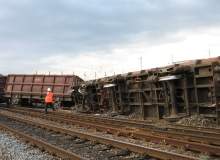

Frances Marcellin: What was the motivation behind creating this course?
Graham Braithwaite: In 2004, Cranfield launched a new three-week continuing professional development course called ‘Fundamentals of Accident Investigation’, which was developed with the guidance of the three DfT [Department for Transport] Accident Investigation Branches: Air, Rail and Marine. The multimodal course focused on the core skills required by an accident investigator and now runs three times per year.
How well do you really know your competitors?
Access the most comprehensive Company Profiles on the market, powered by GlobalData. Save hours of research. Gain competitive edge.

Thank you!
Your download email will arrive shortly
Not ready to buy yet? Download a free sample
We are confident about the unique quality of our Company Profiles. However, we want you to make the most beneficial decision for your business, so we offer a free sample that you can download by submitting the below form
By GlobalDataIn responding to the requests of individuals and their employers that such courses were assessed and with the option to be accredited, we formally launched the MSc in Safety and Accident Investigation in 2005, initially with an air transport stream and since 2013 with marine and rail streams.
The postgraduate level recognises that investigators tend to be experienced industry professionals moving into a second career as an investigator. The split of taught modules and research (50:50) is aimed at publishing some of the great science that is done by investigators during the course of their job that has not always been widely shared.
FM: How has Cranfield University’s expertise in aircraft accident investigation supported the development of this new rail safety postgraduate course?
GB: Cranfield has been training aircraft accident investigators from around the world since 1977, with the main elements of our success being the close collaboration with industry which enables us to use experienced investigators alongside our own twelve academic staff to deliver courses that are industry-relevant. This is combined with an emphasis on practical, hands-on learning experiences such as our simulated accidents and the use of our unique crash laboratory. Our customers tend to be national investigation agencies, operators, manufacturers and regulators who may put their new-found investigation skills into practice the day after they leave the course.
Our experience in training aircraft accident investigators was recognised in 2011 with a Queen’s Anniversary Prize – the highest honour that can be awarded to a UK academic institution. The sharing of experience between the rail, marine and air modes has benefited all of them, not least because many of the key elements of good accident investigation are common to all of them.
FM: Who is the course designed for?
Recent statistics reveal that four of the top ten UK crime hot spots are major railway stations.
GB: The course is very much designed for experienced industry professionals who have recently moved into an investigation role or who are looking to do so. We try and discourage someone who has just completed their first degree as only those with a combination of technical experience and the qualities to become a good investigator are likely to be employed in such a role. The MSc is a considerable investment in time and money and we want to ensure it is truly career enhancing for the individual, so we really don’t want to attract people under false pretences.
FM: What skills, attitude and qualities do people need to be involved with rail safety and accident investigation?
GB: Accident investigation requires a specialist generalist – they need to be knowledgeable but at the same time recognise the limits of their knowledge and seek the help of domain experts. They need to be patient, dispassionate and methodical, yet tenacious and courageous. They need to be able to solve often complex problems based on evidence – some of which may have perished, been altered or be contradictory.
They need to be able to cope with difficult human elements such as talking to witnesses or relatives and equally be able to project credibility when talking to specialists or perhaps addressing a coroner. Above all, a good investigator demonstrates integrity – their opinion is of no importance without robust analysis of evidence.
FM: Can you describe the different training methods on the course?
GB: As an MSc course, there are a mix of lectures, workshops and practical sessions. The emphasis is not on remembering facts, it is on developing the right mind-set and exposing students to the many different methods and schools of thought that are relevant to the multidisciplinary subject of accident investigation.
In terms of lectures, we might have a professor talking about analysis models in the morning, a family member talking about the needs of victims in the afternoon, followed by an investigation case study by a current or recently retired accident investigator. This may be followed by a walk-through of a mock accident site the following day and a photography workshop after that.
FM: Can you provide more details on how the teaching methods bring out the best in the students practically and academically?
GB: We have a strong academic team of twelve staff, many of whom have worked as investigators or in support of investigations. This team is supplemented by around 50 visiting lecturers who tend to work, or who have recently retired, as investigators, or in related or relevant fields.
An hour spent with the relative of an accident victim is a powerful experience for new investigators, but so too is the mock courtroom session with a solicitor advocate or a witness interview observed by a senior accident investigator and police interview trainer. The whole course is designed to build the core skills for investigation and then, through our optional modules, allow an individual to specialise in a particular area, such as engineering forensics or human performance.
FM: Can you describe the various types of simulations you run?
GB: The accident simulations are a crucial part of our course. Rail accident investigators may find themselves spending three days investigating a fishing boat sinking as part of their initial training in order to take them out of their comfort zone and focus on investigation rather than their existing knowledge of the rail industry. This then builds to a longer (five day) accident simulation which is mode-specific.
We have used the Northampton and Lamport Heritage Railway and Motorail’s Long Marston facilities for railway simulations, our own fishing boat and an Isle of Wight ferry for marine simulations, and our own airport to stage aircraft accidents using vehicles usually recovered from real accidents and donated by operators or their insurers. For example, Virgin Trains very generously donated a Pendolino coach from the Grayrigg accident which is set up in our accident investigation laboratory alongside damaged aircraft, boats and components.
FM: What goes into the planning of a successful simulation?
GB: The creation of a plausible scenario is key to a powerful learning experience. This means sourcing suitable vehicles and locations and writing a script which is wide enough to cope with the fact that it is impossible to predict everything our investigation teams may try and examine. Scripts for our witnesses often go on for many pages and are carefully written by retired investigators who draw upon their case history to create realistic characters and challenges.
Some of our administrative and academic colleagues play roles and we are also fortunate that past students will come back and play parts so that the students are never talking to characters they have met before. We go to a lot of effort to make the details right, which has meant sourcing some strange things over the years, including uniforms, wallets, phones, theatrical blood and even a level crossing from the set of EastEnders.




